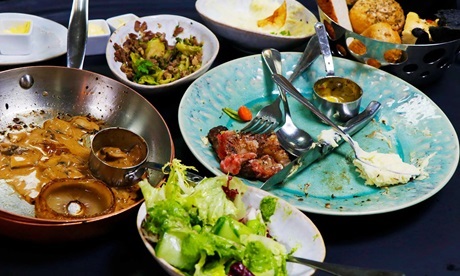According to the United Nations’ Food and Agricultural Organisation (FAO), about one-third of all food produced for human consumption is wasted.
Biggest challenge
If we drill down, food waste in food service businesses (FSBs) and retail outlets is the main challenge, because many resources have already been invested in food that’s then discarded at the end of the supply chain.
Food waste in hospitality has intensified post-pandemic due to the increasing rate of out-of-home food consumption and growth of tourism, according to international studies conducted in 2017, 2020 and 2021.
For example, the UK hospitality industry wastes about 920,000 tonnes of food in a single year, which makes the UK the largest food-waste country in Europe.
In the United States, the hospitality industry is responsible for 500 million tons of food waste annually.
The Australian hospitality industry generates 1.22 million tonnes of food waste per year. China has about 34 million tonnes of food waste in its cities annually.
Food waste in the Australian hospitality industry
We explored food waste in the Australian hospitality industry by interviewing managers, owners, customer service employees, kitchenhands and chefs.
Our aim was to identify a rich variety of perspectives from 20 FSBs, ranging from fast-food to high-end restaurants.
Our findings show:
- Conflicting perceptions among different stakeholders in the food industry about food waste and who is responsible.
For instance, despite expectations from policymakers and the community for the industry to take responsibility, the industry is actually hesitant.
It is reluctant to enforce too many restrictions to influence consumers and affect their eating-out experience.
Also, neither FSB employees nor consumers consider wasting food as unethical.
- Food waste is not considered a “discrete” activity, but is integrated into other routines and beliefs.
Food waste is an industry norm because consumer demand is unpredictable.
Hence, ordering in bulk from suppliers, preparing/cooking more to safeguard from uncertain demand, and wasting the leftovers is accepted.
- Food waste “hotspots” vary depending on different FSB domains.
In fast food, food waste hotspots were associated with consumption practices. Mid to high-range FSBs created more waste during food preparation and during cooking, primarily driven by chefs to achieve “perfection”.
Wastage continues to increase
All food wastage in the hospitality industry has substantial negative implications for the economy.
These include losses on the costs of the food purchased and prepared but not consumed), for society (food insecurity), and the environment (climate change and biodiversity loss).
Despite the hospitality industry and FSBs being inundated with diverse action plans (and strategies) to combat food waste, studies show the volume of food waste continues to increase.
This is because food practices are deeply embedded in diverse daily practices, making it hard to change with just singular action plans.
Industry norm
During our research, we collected the following quote from a venue manager about the industry norm in food waste:
“There are two main areas with a big impact on your wastage.
In terms of the factors that we can’t control – sales. For example, if it’s a rainy day, you might not be as busy. You might not get so much waste.
“Accordingly, you have to look at a lot of different variables when you do your forecasting, and it comes down to a certain amount of luck, because you can forecast as close as possible, but something outside could have an effect.
“And that’s the tricky part in this industry where wastage happens.
“A lot of places find it hard to manage wastage, and sometimes just outright give up, because it’s too many variables to control.”
And this from a customer service worker or server:
“In this industry, the food has always been wasted no matter what you do. Because when people do order food, especially on the table, they order more than what is supposed to be.
“Sometimes people do order a lot, more than what they can eat …. I think I always suggest to them it’s already too much.
“But then, it is the customer’s choice – you can’t force them not to buy food.
“It hurts when we dump that food into the waste bin, which honestly could feed many other people if we could have saved those things”.
The server said customers eat with their eyes.
“They want to see a big pile of food.
“From a review standpoint, people want to see a large plate of food in front of them. Whether or not they finish it, they believe that’s entirely up to them.
“But if we [FSB staff] were to reduce the portion size, we would see huge feedback, such as, ‘It’s not as large as what it used to be’.
“And they’re not acknowledging from their point of view that, or maybe it was excessive because they weren’t finishing it”
How to reduce food waste
We’ve drawn up two lists of recommendations to help food businesses and also consumers.
For food businesses
- Food waste can be avoided through collaboration with consumers without sacrificing the profit motive.
- Despite FSBs placing bulk orders to obtain discounts, technology-based forecasting and inventory management approaches can provide cost-effective solutions to managing food waste.
- Use the offcuts during preparation or the untouched prepared food at the end of the day to make other food items such as sauces, soups or juices.
- Make the sides – vegetables, potatoes or chips – optional.
- Provide training to staff on how to prepare and/or cook without wasting food, even if staff turnover is high.
- Invest in proper storage infrastructure to keep extra items fresh longer, especially cold storage for fresh produce.
For consumers
- Know about the ingredients in your dish before ordering or trying any new food to avoid throwing it away because the delivered food isn’t what you expected.
- If you’re hosting guests, shift your focus to quality of food, not quantity.
- If you’re eating out, there’s no shame in taking the leftovers home and eating these later.
- Switch from a large to a medium-sized portion and see if it can satisfy your appetite.
- If you don’t like the sides, request them not to be served. Even though the sides could be cheaper than the main food, wasting them can be as bad as wasting the main food item.
- If your restaurant suggests ways to reduce food waste, follow their advice. By reducing food waste, restaurants can help you save money, support society through food banks, and protect the environment, too.
A challenge for all of us
Superficial action to change behaviour cannot solve a serious social challenge such as food waste.
But our findings provide a nuanced understanding about how repeated applications of deeply-rooted social practices make food waste a default phenomenon in FSBs.
It’s therefore important to see food waste as a challenge for everyone, and use a holistic approach that can challenge and modify the entrenched beliefs regarding food and food waste.
This is extremely important due to the growing professional expectations in the hospitality industry to manage food waste efficiently and support sustainability.
- First published in Lens
- Alka Nand is a Lecturer, Department of Management, Monash Business School;
- Ananya Bhattacharya is a Senior Lecturer, Department of Management, Monash Business School;
- Amrik Sohal is a Professor in the Department of Management, Faculty of Business and Economics;
- Daniel Prajogo is a Professor, Department of Management, Faculty of business;
- Tharaka De Vass is a Research Fellow, Monash Business School
News category: Analysis and Comment.




